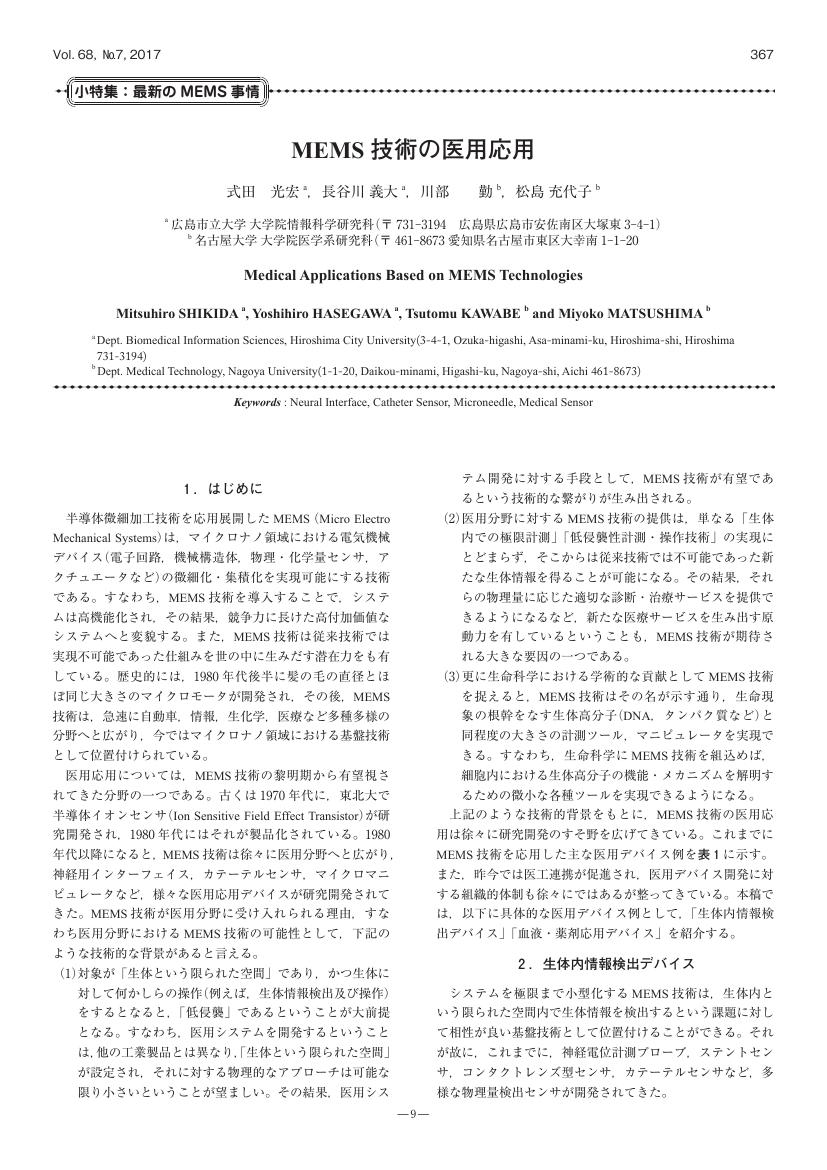1 0 0 0 OA MEMS技術の医用応用
- 著者
- 式田 光宏 長谷川 義大 川部 勤 松島 充代子
- 出版者
- 一般社団法人 表面技術協会
- 雑誌
- 表面技術 (ISSN:09151869)
- 巻号頁・発行日
- vol.68, no.7, pp.367-372, 2017-07-01 (Released:2018-07-01)
- 参考文献数
- 38
1 0 0 0 OA 数学教育におけるジグソー学習法に関する研究と 数学的コミュニケーション研究との比較
- 著者
- 松島 充
- 出版者
- 全国数学教育学会
- 雑誌
- 数学教育学研究 : 全国数学教育学会誌 (ISSN:13412620)
- 巻号頁・発行日
- vol.19, no.2, pp.117-126, 2013-06-22 (Released:2019-01-17)
- 参考文献数
- 34
The purpose of this research throws new light upon a connection between research of the Jigsaw Method on Mathematics Education and research of mathematical communication based on these comparisons. The greatest feature of Jigsaw Method on Mathematics Education is securing the opportunity of an argumentation to all the children. This is a foundation of the structural aspect of the Jigsaw Method on Mathematics Education as a group learning method. The foundation of this structural aspect has the feature of four more points. They are “a setup of two or more expert subjects”, “a setup of the integrative viewpoint of an argumentation”, “problem solving according to people two or more”, and “serious consideration of justification.” Two points are mentioned as a practical feature for a teacher to actually practice the Jigsaw Method on Mathematics Education. They are “support in an expert group”, and “ascertaining of group support.” As for these, both are concerned with momentary judgment within a lesson. This is the contents relevant to teacher education. In my general survey of the previous study of mathematical communication, it was arranged by four views which were aim of education, way of education, development of mathematical communication, and structure of mathematical communication. The research as aim of education was able to find out the common feature with the structural aspect of the Jigsaw Method on Mathematics Education. The research as way of education was able to point out the common feature with the Jigsaw Method on Mathematics Education about growth of the knowledge by an argumentation from the epistemological feature based on social constructivism. The research as development of mathematical communication pointed out that two points, a setup of the viewpoint of the integrative argumentation from the structural aspect and the practical feature, had a common feature. However, two points of the practical feature showed the necessity of making it concerned with a theory of teacher education. The research as the structure of mathematical communication pointed out that the epistemology in mathematics education is related with the Jigsaw Method on Mathematics Education. The next question of this research was pointed out four things. First of all, it is constructs the creation principle of the teaching materials that is based on the structural aspect of the Jigsaw Method on Mathematics Education. Secondly, it is constructs of the creation principle of the lesson that is based on the practical feature of the Jigsaw Method on Mathematics Education. Thirdly , the research on the relation of the practical feature of the Jigsaw Method on Mathematics Education and teacher education are needed to investigate. Finally, the new practice of the Jigsaw Method on Mathematics Education which utilized ICT are also needed to investigate.
農薬の毒性は害虫に特異的ではなく、近年主流のアセチルコリン作動系農薬もヒトや生態系への影響が懸念されている。農薬が生体に及ぼす影響は多岐にわたり、神経系への毒性だけでは正確に有害性を検討することは困難である。本研究では農薬による生体防御反応の誘導能および免疫応答の攪乱作用に着目し、比較的安全とされるネオニコチノイド系農薬を含めアセチルコリン作動系農薬の影響を生体側から解明する。平成29年度は生体防御反応の誘導能を中心に解析を行った。ストレス応答系としてHO-1の発現、異物代謝系としてオートファジーの誘導(LC3-IIの誘導およびp62の発現)を評価することにより生体防御反応の誘導能の解析を行った。農薬は有機リン系農薬のダイアジノンおよびネオニコチノイド系農薬のアセタミプリドを使用した。細胞はマウスマクロファージ細胞株RAW264.7細胞を用いた。ダイアジノンはRAW264.7細胞においてストレス応答系のHO-1および異物代謝系のオートファジーを強く誘導することが明らかとなった。一方、アセタミプリドについてはHO-1の誘導はほとんど認められなかったが、オートファジーについてはダイアジノンと比較すると非常に弱いものの、オートファジーの誘導が認められた。以上の結果より、同じアセチルコリン作動系農薬であっても生体防御反応の誘導能の程度が異なり、異なる作用機序が存在する可能性が示唆された。
